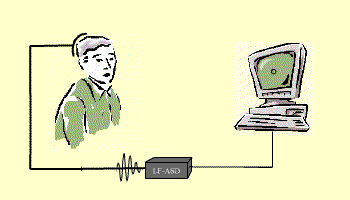Hope For The Paralyzed: Restoring The Ability To Type Through Use Of A Brain-Computer Interface
In a story right out of science fiction this post details work published in the Open Access journal eLife on February 21, 2017 titled "High performance communication by people with paralysis using an intracortical brain-computer interface."
Brain-Computer Interface

The initial goal of the projects involved in developing a direct interface between the brain and a computer have been to assist people who are tetraplegic/quadriplegic (those who have lost control of all four limbs) communicate. To do this researchers have been creating devices (brain-computer interface devices or BCI) which can be implanted into the brain, and receive electrical signals from brain neurons. These signals can then be transported and interpreted by a computer.

As a site note there are also less invasive BCI devices which sit on the surface of the scalp to detect brain activity.
You may be surprised to find that such BCI devices have existed since the 1990's where researchers were using signals from the motor cortex of the brain to move robotic arms. [3] Work progressed on these devices for the past few decades but any and all clinical devices never performed well enough to justify the use by people with speech issues.
This Study Used The Brain-Gate And Asked People To Type
In this study the participants (there were only three) were using a BCI called a brain gate, which allowed them to move a mouse cursor on a computer screen with their minds. The computer screen displayed the alphabet, so the participants could select letters and type out words. The speed at which the participants were able to do this was then measured and recorded.
Here is a video of one participant using the device to select letters and type some sentences:
The authors tried a few different keyboards and recorded the typing speeds of the participants:

The OPTI-II keyboard (a) in the figure above was the fastest choice for the participant in the video, she managed to type 31.6 ± 8.7 characters per minute. A different participant managed 36.1 ± 0.9 characters per minute with the QWERTY keyboard (b) and an even faster 39.2 ± 1.2 characters per minute with the OPTI-II keyboard!
These character numbers average to around 7-8 words per minute! These rates are faster then ever before observed for any prior study on a BCI, making the work done here particularly remarkable! Remember these are participants who do not have motor control enough to be able to move or type, and here they are able to do that typing with their mind at up to 8 words per minute.
At Minimum How Fast Do People Want To Communicate?
The authors report that in a previous study asking people with ALS how fast communication would need to be for them to be satisfied with it 59% said only a speed of 3 words per minute and 72% said they would be happy with 4 words per minute. [4] This technology was allowing participants to go at speeds almost double what ALS patients said they would be happy with!
TL;DR?
Using a brain implant, which allowed participants to move a mouse cursor to select letters on an on-screen keyboard. Paralyzed participants were able to type at rates upwards of 8 words per minute, allowing these people a significantly faster method of communication then is available through any other current technology. Quite fascinating, promising and extremely exciting experiments!
Sources
- https://elifesciences.org/content/6/e18554
- http://www.nature.com/nature/journal/v416/n6877/full/416141a.html
- https://www.ncbi.nlm.nih.gov/pubmed/10404201
- http://www.tandfonline.com/doi/full/10.3109/17482968.2011.572978
All Non Cited Images Are From Pixabay.com And Are Available Under Creative Commons Licenses Or From The Original Research Article From eLife Which Allows For Re-production Of Figures Under A Creative Commons License.
Any Gifs Are From Giphy.com and Are Also Available for Use Under Creative Commons Licences
If you like my work, please consider giving me a follow: @justtryme90. I am a PhD holding biochemist with a love for science. My future science blog posts will cover a range of topics in the biology/chemistry fields.
Thank you for your continued support of my work! I appreciate all those who follow me (and those who don't too).
This sort of thing has been around for a while, but it's still mind-blowing. I think the three monkeys at 14:15 in this TED Talk are simply amazing. They are not just communicating with the computer, but also coordinating their efforts with each other. I can't wait to see the things that humans will be able to do with that capability.
Yep, its been around since the late 1990's. However the results reported from the participants in this study are the fastest ever observed for this sort of communication.
Checking out the TED talk, thanks!
Edit: So the three monkeys linked together moving the average cursor to a specific location in 3D space is really interesting.
Ooooh, now I can publish even more Steemit posts! >=3
:D